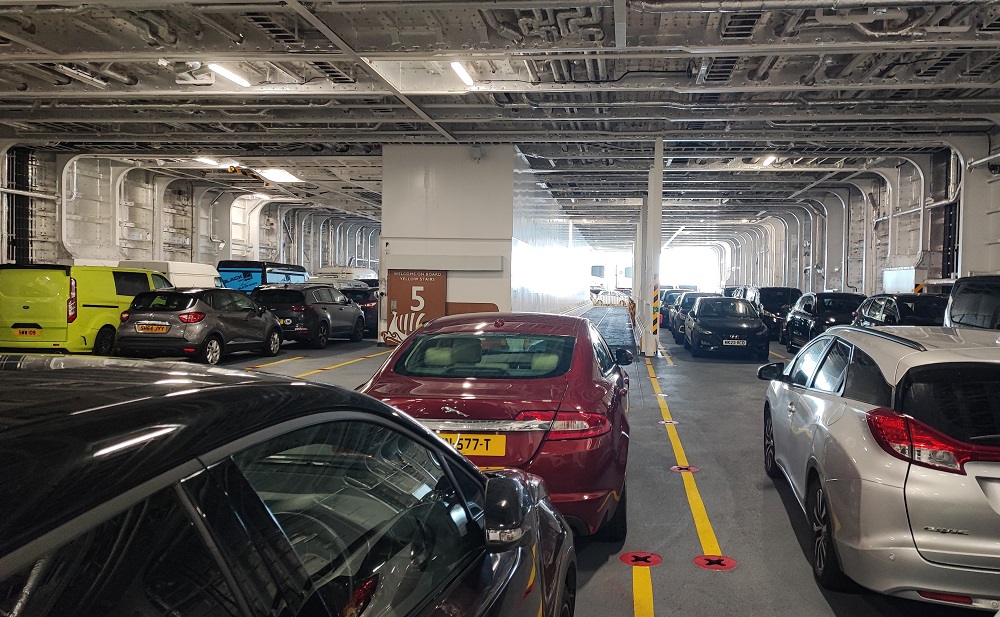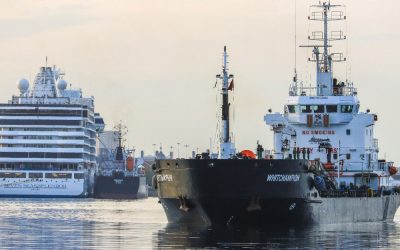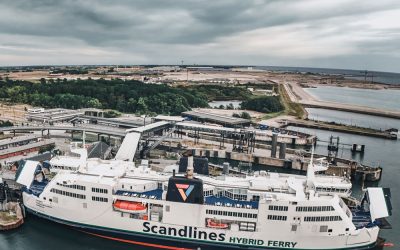Ferry companies, which carry both large and varied numbers of vehicles and a multitude of passengers, could be particularly at risk from fires breaking out on board. This is likely to grow as more and more EVs, powered by lithium-ion batteries, are adopted for private and commercial use. The large numbers of passengers carried on ferry routes also present additional safety concerns not found on ro-ro vessels.
In 2023 several fires took place on large ro-ro vessels carrying sizable quantities of EVs. The most recent of these, onboard the Fremantle Highway, led to the death of one crew member and gutted the vessel. While it has not yet been fully ascertained whether an EV was the primary cause of the fire, the number of vehicles transported has led many to draw this conclusion. The Fremantle Highway fire follows several other cases. Some of these, such as the fire on board the Felicity Ace, led to the total loss of the vessel when it sank off the coast of the Azores.
Complicating matters further is the fact that supplementary safety guidance released can be contradictory. A recent study from the International Association of Marine Insurers (IUMI) concluded that on ro-pax vessels passengers may want to charge their vehicles on board and this should be permitted subject to relevant risk assessments and control measures. According to the study, this is because built-in safety mechanisms are usually activated during charging. Despite this, operators such as DFDS and Brittany Ferries have recently banned the charging of EVs on board.
A proactive approach
Both DFDS and Brittany Ferries are companies who are taking proactive steps ensure they are providing for the safety of passenger and crew on board vessels. The latter has a dedicated training and firefighting centre in St Malo, Brittany, which has served as the hub for its own research, firefighting training and firefighting exercises.
“Passengers and freight companies should be confident that this is an issue that has been – and will continue to be – monitored closely by technical and commercial teams. We take this issue extremely seriously and remain vigilant. We will work with relevant safety authorities such as Bureau Veritas in France on our position,” notes Christopher Jones, communications manager at Brittany Ferries.
The company has also implemented various new safety measures based on its own studies and research by other organisations. For example, the identification of EVs pre-embarkation. Additionally, the company is installing thermal detectors (both mobile and fixed) across its fleet, starting with ships serving long routes to Spain, as well as fire blankets that all crew have been trained to use.
Existing guidance for the carriage of EVs on board ro-ro and ro-pax vessels already advises vessel operators of necessary steps to take regarding increased safety. An updated Maritime Guidance Note (MGN), as of August 2023, from the UK Maritime & Coastguard Agency states that one of the main dangers from EVs stems from so-called thermal runaway. This is the occurrence most associated with EV fires and happens when heat generated within a lithium-ion battery exceeds the amount of heat that is dissipated to its surroundings. The resulting battery temperature will continue to rise considerably, further generating more heat and leading to fire.
The MGN notes that vessel operators should instruct onboard fire patrols to pay attention to evidence of black ‘smoke’ from vehicles as nanoparticles of heavy metals are discharged, followed by white vapour. Damaged high-voltage batteries will also create “popping sounds” which may be indicate a thermal runaway event. Additionally, it states that operators use CCTV or thermal imaging to detect fires which patrols may have missed. A range of new firefighting methods are also recommended as standard pressurised fixed water drench methods may not be enough to deal with the fire suppression needs of EV incidents. Some of these include specialised water lances and upward facing hoses that can directly cool batteries from below, or devices such as water-curtains to reduce the risk of fire spreading to other vehicles.
EV bans
Major fires on board ferries are currently rare. Nevertheless, they do take place. The first EV fire on a ferry occurred in 2010 on the MS Pearl of Scandinavia which was route from Oslo to Copenhagen. The Danish Maritime Authority responded by temporarily banning charging for EVs on vessels. Today some companies have gone further. Seeking to remove the source of the problem altogether Norwegian ferry operator Havila Kystruten has banned EVs completely. The company, which operates the scenic Hurtigruten coastal route between Bergen and Kirkenes, told Norwegian TV service NRK that the consequences of fires would be far too severe and have since banned EVs from this route.
Other companies, such as Stena Line, have been involved in research projects, such as the EU-funded LASHFIRE, to find solutions to the potential problems raised by EV fires. A spokesperson for Stena says that its onboard designated firefighting teams have also received training by an EV firefighting expert and that training is ongoing as more data and best practice procedures become available. The company has taken steps to provide EV specific firefighting equipment to its teams.
The threat of EV fires on board ferries is not limited to larger seagoing vessels and passengers and crew on smaller routes are likely to be wondering what specific procedures smaller companies have in place. The Scottish government-owned Caledonia Macbrayne, whose ferries operate between the Scottish mainland and 22 major islands on Scotland’s west coast, tells TNA it has procedures in place based on existing guidelines. However, the company declined to give specifics.
According to a CalMac spokeswoman: “Like all risks on board a vessel, the risk of carrying electric vehicles has been assessed by trained personnel and we have developed procedures following the release of specific guidance issued by the MCA (MGN 653) and the European Maritime Safety Agency (EMSA). Guidance by the MCA and EMSA was developed through consultation with the industry, and specifically the industry body, InterFerry, of which we are a member.”
Elsewhere, Danish ferry operator DFDS is also taking steps to mitigate the effects of EV fires and ensure the safety of its passengers. The company, which is Northern Europe’s largest integrated shipping and logistics company, operating 30 routes, has installed firefighting equipment on board its vessels specifically for electric vehicles, including special fire blankets and cooling units. As part of its onboard drills DFDS crews also run fire scenarios that include fires in EVs, and all deck and engine officers are required to complete a mandatory E-learning module on the risks of fires in EVs and the firefighting techniques that can be used.
The company has also partnered with the Danish Institute of Fire Safety and Security Technology (DBI) which is also working with ferry operators Scandline and Molslinjen A/S. In 2021 DBI launched the Electric Vehicle Fires at Sea: New Technologies and Methods for Suppression, Containment, and Extinguishing of Battery Car Fires on Board Ships (ELBAS), supported by the Danish Maritime Fund. Initial results from this research initiative have proved optimistic.
“The positive message is that fires in electric cars on board ferries are manageable and not something we need to fear,” according to Alexander Kleiman, maritime R&D project manager at DBI.
“All the fires in our tests could be extinguished, so with the correct firefighting technologies on board, the correct training of the crew and well-coordinated collaboration with the onshore emergency services, electric cars should not pose a safety problem in ferry traffic,” he added.
Risks of lithium-ion battery usage needs constant re-evaluation
Investigations are still ongoing into the causes of recent fires on board vessels such as the Fremantle Highway. However, the increasing numbers of EVs carried on both ro-ro and ro-pax vessels is likely to lead to increased incidents if more rigid safety measures are not adopted. A report published in summer 2023 by insurance agency Allianz notes that due to rapidly evolving technology and a lack of consistent regulation, the risks of lithium-ion battery usage will need to be constantly re-evaluated as they develop over time.
The report concludes: “If the maritime industry is to improve its incident record related to the transport of these battery types, all parties involved in the supply chain must understand the hazards involved, the most common causes and problems associated with transporting in commerce.”
Ferry operators will be cautiously watching closely for any further regulatory developments and new safety measures as they are brought in. The IMO’s Sub-Committee on Ship Systems and Equipment (SSE) will be starting work in March 2024 on the “evaluation of adequacy of fire protection, detection and extinction arrangements in vehicle, special category and ro-ro spaces in order to reduce the fire risk of ships carrying new energy vehicles.” The results of this will no doubt prove useful to the industry but will likely take time to bear fruit.
Companies who are already taking a proactive approach, such as DFDS and Brittany Ferries, may help to set a wider trend. In any case involving safety of life at sea complacency in the face of new hazards cannot be afforded as the costs of a catastrophic incident will be too much to bear.






